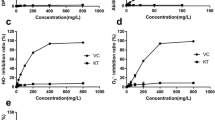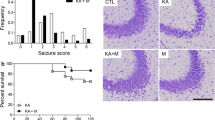Abstract
The involvement of glutamate in neuronal cell death in neurodegenerative diseases and neurotrauma is mediated through excitotoxicity or oxytosis. The latter process induces oxidative stress via glutamate-mediated inhibition of cysteine transporter xCT, leading to depletion of the cellular glutathione pool. Mitochondrial damage, loss of mitochondrial membrane potential (MMP), and depletion of energy metabolites have been shown in this process. The Voltage-Dependent Anion Channel-1 (VDAC1) is one of the main components of the mitochondrial outer membrane and plays a gatekeeping role in mitochondria-cytoplasm transport of metabolites. In this study, we explored the possible participation of VDAC-1 in the pathophysiology of oxytosis. Administration of glutamate in HT22 cells that lack the glutamate ionotropic receptors induced an upregulation and oligomerization of VDAC1. This was associated with an increase in ROS and loss of cell survival. Glutamate-mediated oxytosis in this model also decreased MMP and promoted ATP depletion, resulting in translocation of cytochrome c (cyt C) and apoptosis inducing factor (AIF) from mitochondria into the cytosol. This was also accompanied by cleavage of AIF to form truncated AIF. Inhibition of VDAC1 oligomerization using 4,4′-Diisothiocyanatostilbene-2,2′-disulfonate (DIDS), significantly improved the cell survival, decreased the ROS levels, improved mitochondrial functions, and decreased the mitochondrial damage. Notably, DIDS also inhibited the mitochondrial fragmentation caused by glutamate, indicating the active role of VDAC1 oligomerization in the process of mitochondrial fragmentation in oxytosis. These results suggest a critical role for VDAC1 in mitochondrial fragmentation and its potential therapeutic value against glutamate-mediated oxidative neurotoxicity.







Similar content being viewed by others
References
Abu-Hamad S, Arbel N, Calo D, Arzoine L, Israelson A, Keinan N, Ben-Romano R, Friedman O, Shoshan-Barmatz V (2009) The VDAC1 N-terminus is essential both for apoptosis and the protective effect of anti-apoptotic proteins. J Cell Sci 122(Pt 11):1906–1916. https://doi.org/10.1242/jcs.040188
Ben-Hail D, Shoshan-Barmatz V (2016) VDAC1-interacting anion transport inhibitors inhibit VDAC1 oligomerization and apoptosis. Biochim Biophys Acta 1863 (7 Pt A):1612–1623. https://doi.org/10.1016/j.bbamcr.2016.04.002
Chaanine AH, Gordon RE, Kohlbrenner E, Benard L, Jeong D, Hajjar RJ (2013) Potential role of BNIP3 in cardiac remodeling, myocardial stiffness, and endoplasmic reticulum: mitochondrial calcium homeostasis in diastolic and systolic heart failure. Circ Heart Fail 6(3):572–583. https://doi.org/10.1161/CIRCHEARTFAILURE.112.000200
Daugas E, Susin SA, Zamzami N, Ferri KF, Irinopoulou T, Larochette N, Prevost MC, Leber B, Andrews D, Penninger J, Kroemer G (2000) Mitochondrio-nuclear translocation of AIF in apoptosis and necrosis. FASEB J 14(5):729–739
De Pinto V, Reina S, Gupta A, Messina A, Mahalakshmi R (2016) Role of cysteines in mammalian VDAC isoforms’ function. Biochim Biophys Acta 1857(8):1219–1227. https://doi.org/10.1016/j.bbabio.2016.02.020
DeHart DN, Fang D, Heslop K, Li L, Lemasters JJ, Maldonado EN (2018) Opening of voltage dependent anion channels promotes reactive oxygen species generation, mitochondrial dysfunction and cell death in cancer cells. Biochem Pharmacol 148:155–162. https://doi.org/10.1016/j.bcp.2017.12.022
Dixon SJ, Lemberg KM, Lamprecht MR, Skouta R, Zaitsev EM, Gleason CE, Patel DN, Bauer AJ, Cantley AM, Yang WS, Morrison B, Stockwell BR (2012) Ferroptosis: an iron-dependent form of nonapoptotic cell death. Cell 149(5):1060–1072. https://doi.org/10.1016/j.cell.2012.03.042
Edison N, Curtz Y, Paland N, Mamriev D, Chorubczyk N, Haviv-Reingewertz T, Kfir N, Morgenstern D, Kupervaser M, Kagan J, Kim HT, Larisch S (2017) Degradation of Bcl-2 by XIAP and ARTS promotes apoptosis. Cell Rep 21(2):442–454. https://doi.org/10.1016/j.celrep.2017.09.052
Fonnum F (1984) Glutamate: a neurotransmitter in mammalian brain. J Neurochem 42(1):1–11
Fukui M, Song JH, Choi J, Choi HJ, Zhu BT (2009) Mechanism of glutamate-induced neurotoxicity in HT22 mouse hippocampal cells. Eur J Pharmacol 617(1–3):1–11. https://doi.org/10.1016/j.ejphar.2009.06.059
Geula S, Ben-Hail D, Shoshan-Barmatz V (2012) Structure-based analysis of VDAC1: N-terminus location, translocation, channel gating and association with anti-apoptotic proteins. Biochem J 444(3):475–485. https://doi.org/10.1042/BJ20112079
Itoh K, Nakamura K, Iijima M, Sesaki H (2013) Mitochondrial dynamics in neurodegeneration. Trends Cell Biol 23(2):64–71. https://doi.org/10.1016/j.tcb.2012.10.006
Kang Y, Tiziani S, Park G, Kaul M, Paternostro G (2014) Cellular protection using Flt3 and PI3Kalpha inhibitors demonstrates multiple mechanisms of oxidative glutamate toxicity. Nat Commun 5:3672. https://doi.org/10.1038/ncomms4672
Keinan N, Tyomkin D, Shoshan-Barmatz V (2010) Oligomerization of the mitochondrial protein voltage-dependent anion channel is coupled to the induction of apoptosis. Mol Cell Biol 30(24):5698–5709. https://doi.org/10.1128/MCB.00165-10
Keinan N, Pahima H, Ben-Hail D, Shoshan-Barmatz V (2013) The role of calcium in VDAC1 oligomerization and mitochondria-mediated apoptosis. Biochim Biophys Acta 1833(7):1745–1754. https://doi.org/10.1016/j.bbamcr.2013.03.017
Knott AB, Perkins G, Schwarzenbacher R, Bossy-Wetzel E (2008) Mitochondrial fragmentation in neurodegeneration. Nat Rev Neurosci 9(7):505–518. https://doi.org/10.1038/nrn2417
Landshamer S, Hoehn M, Barth N, Duvezin-Caubet S, Schwake G, Tobaben S, Kazhdan I, Becattini B, Zahler S, Vollmar A, Pellecchia M, Reichert A, Plesnila N, Wagner E, Culmsee C (2008) Bid-induced release of AIF from mitochondria causes immediate neuronal cell death. Cell death differentiation 15(10):1553–1563. https://doi.org/10.1038/cdd.2008.78
Lewerenz J, Maher P (2015) Chronic glutamate toxicity in neurodegenerative diseases-what is the evidence? Front Neurosci 9:469. https://doi.org/10.3389/fnins.2015.00469
Lewerenz J, Ates G, Methner A, Conrad M, Maher P (2018) Oxytosis/ferroptosis-(Re-) emerging roles for oxidative stress-dependent non-apoptotic cell death in diseases of the central nervous system. Front Neurosci 12:214. https://doi.org/10.3389/fnins.2018.00214
Liu Z, Luo Q, Guo C (2015) Bim and VDAC1 are hierarchically essential for mitochondrial ATF2 mediated cell death. Cancer Cell Int 15:34. https://doi.org/10.1186/s12935-015-0188-y
Maher P, van Leyen K, Dey PN, Honrath B, Dolga A, Methner A (2018) The role of Ca(2+) in cell death caused by oxidative glutamate toxicity and ferroptosis. Cell Calcium 70:47–55. https://doi.org/10.1016/j.ceca.2017.05.007
Malia TJ, Wagner G (2007) NMR structural investigation of the mitochondrial outer membrane protein VDAC and its interaction with antiapoptotic Bcl-xL. Biochemistry 46(2):514–525. https://doi.org/10.1021/bi061577h
Manczak M, Reddy PH (2012) Abnormal interaction of VDAC1 with amyloid beta and phosphorylated tau causes mitochondrial dysfunction in Alzheimer’s disease. Hum Mol Genet 21(23):5131–5146. https://doi.org/10.1093/hmg/dds360
McCommis KS, Baines CP (2012) The role of VDAC in cell death: friend or foe? Biochim Biophys Acta 1818(6):1444–1450. https://doi.org/10.1016/j.bbamem.2011.10.025
Mishra P, Chan DC (2016) Metabolic regulation of mitochondrial dynamics. J Cell Biol 212(4):379–387. https://doi.org/10.1083/jcb.201511036
Nagakannan P, Iqbal MA, Yeung A, Thliveris JA, Rastegar M, Ghavami S, Eftekharpour E (2016) Perturbation of redox balance after thioredoxin reductase deficiency interrupts autophagy-lysosomal degradation pathway and enhances cell death in nutritionally stressed SH-SY5Y cells. Free Radic Biol Med 101:53–70. https://doi.org/10.1016/j.freeradbiomed.2016.09.026
Neitemeier S, Jelinek A, Laino V, Hoffmann L, Eisenbach I, Eying R, Ganjam GK, Dolga AM, Oppermann S, Culmsee C (2017) BID links ferroptosis to mitochondrial cell death pathways. Redox Biol 12:558–570. https://doi.org/10.1016/j.redox.2017.03.007
Olney JW (1969) Brain lesions, obesity, and other disturbances in mice treated with monosodium glutamate. Science 164(3880):719–721
Otera H, Ohsakaya S, Nagaura Z, Ishihara N, Mihara K (2005) Export of mitochondrial AIF in response to proapoptotic stimuli depends on processing at the intermembrane space. EMBO J 24(7):1375–1386. https://doi.org/10.1038/sj.emboj.7600614
Pamenter ME, Perkins GA, Gu XQ, Ellisman MH, Haddad GG (2013) DIDS (4,4-diisothiocyanatostilbenedisulphonic acid) induces apoptotic cell death in a hippocampal neuronal cell line and is not neuroprotective against ischemic stress. PloS ONE 8(4):e60804. https://doi.org/10.1371/journal.pone.0060804
Polster BM, Basanez G, Etxebarria A, Hardwick JM, Nicholls DG (2005) Calpain I induces cleavage and release of apoptosis-inducing factor from isolated mitochondria. J Biol Chem 280(8):6447–6454. https://doi.org/10.1074/jbc.M413269200
Rambold AS, Kostelecky B, Elia N, Lippincott-Schwartz J (2011) Tubular network formation protects mitochondria from autophagosomal degradation during nutrient starvation. Proc Natl Acad Sci USA 108(25):10190–10195. https://doi.org/10.1073/pnas.1107402108
Reddy PH (2013) Is the mitochondrial outermembrane protein VDAC1 therapeutic target for Alzheimer’s disease? Biochim Biophys Acta 1832(1):67–75. https://doi.org/10.1016/j.bbadis.2012.09.003
Sahlender DA, Savtchouk I, Volterra A (2014) What do we know about gliotransmitter release from astrocytes? Philosophical transactions of the Royal Society of London Series B. Biol Sci 369(1654):20130592. https://doi.org/10.1098/rstb.2013.0592
Sanderson TH, Raghunayakula S, Kumar R (2015) Release of mitochondrial Opa1 following oxidative stress in HT22 cells. Mol Cell Neurosci 64:116–122. https://doi.org/10.1016/j.mcn.2014.12.007
Santello M, Cali C, Bezzi P (2012) Gliotransmission and the tripartite synapse. Adv Exp Med Biol 970:307–331. https://doi.org/10.1007/978-3-7091-0932-8_14
Savtchouk I, Volterra A (2018) Gliotransmission: beyond black-and-white. J Neurosci 38(1):14–25. https://doi.org/10.1523/JNEUROSCI.0017-17.2017
Shoshan-Barmatz V, Mizrachi D (2012) VDAC1: from structure to cancer therapy. Front Oncol 2:164. https://doi.org/10.3389/fonc.2012.00164
Shoshan-Barmatz V, Zakar M, Rosenthal K, Abu-Hamad S (2009) Key regions of VDAC1 functioning in apoptosis induction and regulation by hexokinase. Biochim Biophys Acta 1787(5):421–430. https://doi.org/10.1016/j.bbabio.2008.11.009
Shoshan-Barmatz V, Keinan N, Abu-Hamad S, Tyomkin D, Aram L (2010) Apoptosis is regulated by the VDAC1 N-terminal region and by VDAC oligomerization: release of cytochrome c, AIF and Smac/Diablo. Biochim Biophys Acta 1797(6–7):1281–1291. https://doi.org/10.1016/j.bbabio.2010.03.003
Shoshan-Barmatz V, De S, Meir A (2017) The mitochondrial voltage-dependent anion channel 1, Ca(2+) transport, apoptosis, and their regulation. Front Oncol 7:60. https://doi.org/10.3389/fonc.2017.00060
Shoshan-Barmatz V, Nahon-Crystal E, Shteinfer-Kuzmine A, Gupta R (2018) VDAC1, mitochondrial dysfunction, and Alzheimer’s disease. Pharmacol Res 131:87–101. https://doi.org/10.1016/j.phrs.2018.03.010
Su B, Wang X, Zheng L, Perry G, Smith MA, Zhu X (2010) Abnormal mitochondrial dynamics and neurodegenerative diseases. Biochim Biophys Acta 1802(1):135–142. https://doi.org/10.1016/j.bbadis.2009.09.013
Tan S, Schubert D, Maher P (2001) Oxytosis: a novel form of programmed cell death. Curr Top Med Chem 1(6):497–506
Twig G, Shirihai OS (2011) The interplay between mitochondrial dynamics and mitophagy. Antioxid Redox Signal 14(10):1939–1951. https://doi.org/10.1089/ars.2010.3779
van Leyen K, Siddiq A, Ratan RR, Lo EH (2005) Proteasome inhibition protects HT22 neuronal cells from oxidative glutamate toxicity. J Neurochem 92(4):824–830. https://doi.org/10.1111/j.1471-4159.2004.02915.x
Voronina SG, Barrow SL, Gerasimenko OV, Petersen OH, Tepikin AV (2004) Effects of secretagogues and bile acids on mitochondrial membrane potential of pancreatic acinar cells: comparison of different modes of evaluating DeltaPsim. J Biol Chem 279(26):27327–27338. https://doi.org/10.1074/jbc.M311698200
Zhou Y, Danbolt NC (2014) Glutamate as a neurotransmitter in the healthy brain. J Neural Transm (Vienna) 121(8):799–817. https://doi.org/10.1007/s00702-014-1180-8
Funding
Funding was provided by Health Sciences Centre Foundation and Paralyzed Veterans of America.
Author information
Authors and Affiliations
Corresponding author
Rights and permissions
About this article
Cite this article
Nagakannan, P., Islam, M.I., Karimi-Abdolrezaee, S. et al. Inhibition of VDAC1 Protects Against Glutamate-Induced Oxytosis and Mitochondrial Fragmentation in Hippocampal HT22 Cells. Cell Mol Neurobiol 39, 73–85 (2019). https://doi.org/10.1007/s10571-018-0634-1
Received:
Accepted:
Published:
Issue Date:
DOI: https://doi.org/10.1007/s10571-018-0634-1




